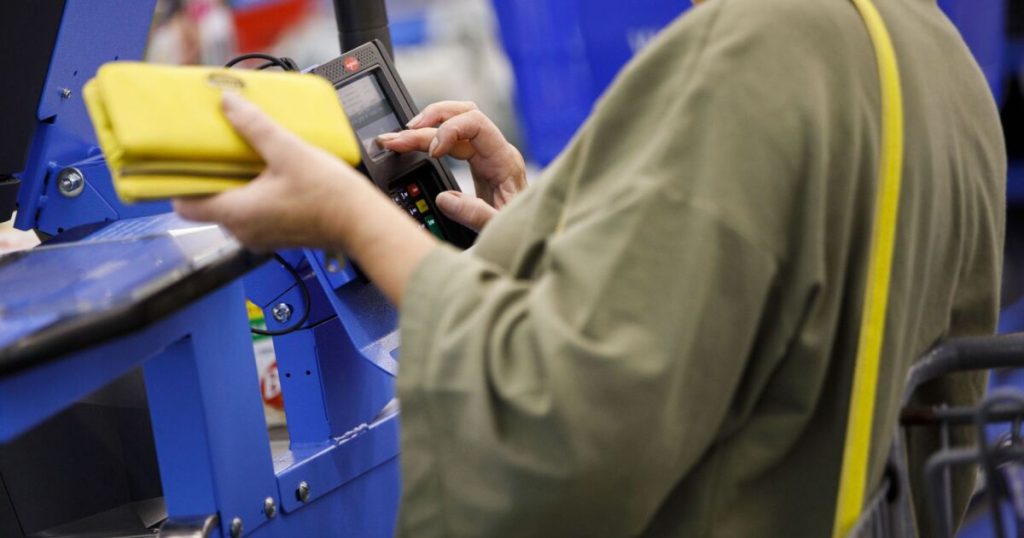Patrick T. Fallon/Bloomberg
A key inflation reading showed price growth leveling off slightly above the Federal Reserve’s target, but details of the report underscore the central bank’s reluctance to lower interest rates.
The Bureau of Economic Analysis’s latest personal consumption expenditure report, released Friday, shows inflation ran at 2.5% in February,
Both readings were in line with Wall Street expectations, though core PCE came in slightly above its projected 2.7%.
Beneath the headline figures, goods inflation picked up during February, with that category rising 3.6% from the same point a year ago, continuing a months-long trend of faster growth that bucks the long-running tendency of goods becoming cheaper over time.
The uptick was offset somewhat by cooling services inflation, which declined 0.1% month to month and came in half a percentage point below the January reading. This includes the critical
Fed Gov. Adriana Kugler, in a speech on Tuesday, said high goods inflation not only affects the immediate outlook for pricing trends, it can also increase long-term expectations, which, in turn, perpetuate further increases.
“This development is unhelpful because goods inflation has often kept a lid on total inflation and also affects inflation expectations,” Kugler said. “In addition to the increase in prices already captured in official data, surveys show that consumers are expecting further increases in the near term.”
Kugler, like other Fed officials, attributed elevated near-term inflation expectations to President Donald Trump’s proposed and implemented
While price increases reflected in the February PCE number could include some anticipatory adjustments ahead of tariffs, it is too soon for the duties to have had an actual impact on import costs. Kugler endorsed keeping interest rates steady until there is a clearer view about the “cumulative” effect of the new administration’s policies.
Other Fed officials have already changed their monetary policy expectations in light of sticky inflation and mounting uncertainties. In an interview with Bloomberg TV’s Michael McKee this week, Federal Reserve Bank of Atlanta President Raphael Bostic said he forecasted just one rate cut this year during the Federal Open Market Committee meeting earlier this month, down from the two he projected in December.
“I moved to one mainly because I think we’re going to see inflation be very bumpy and not move dramatically and in a clear way to the 2% target,” Bostic said.
Fed officials have signalled that tariffs will likely increase broad-based prices if implemented as advertised. The question they must answer is whether to treat that increase as a one-time jump in the level of prices — also referred to as transitory inflation — and simply “look through” it rather than adjust policy in response. But with inflation already above the Fed’s target and possibly moving higher, that approach becomes difficult to justify.
Federal Reserve Bank of St. Louis President Alberto Musalem, in his own speech this week, warned about indirect effects of tariffs, which his staff’s research suggests could drive prices up more than the direct impact. He said these second-order increases could be more persistent than the one-off increase of the new tariffs.
“I would be wary of assuming that the impact of tariff increases on inflation will be entirely temporary, or that a full ‘look-through’ strategy will necessarily be appropriate,” Musalem said. “With inflation already above 2% in a full-employment economy, the stakes are potentially higher than they would be if inflation were at or below target, and if consumers and businesses had not recently experienced high inflation, raising their sensitivity to it.”
Federal Reserve Bank of Richmond President Tom Barkin, who delivered prepared remarks at Washington and Lee University on Thursday, said tariffs are not the only point of evolving policy that Fed policymakers need to watch. He said significant changes are also in the works regarding immigration, energy and fiscal policies, all of which could have implications for monetary policy.
Barkin equated trying to set policy in this environment to operating in a “dense fog.”
“It’s not an everyday ‘forecasting is hard’ type of fog,” he said. “It’s a ‘zero visibility, pull over and turn on your hazards’ type of fog.”

